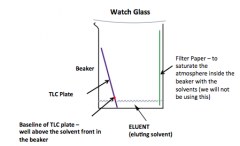![]()
![]()
![]()
Use LEFT and RIGHT arrow keys to navigate between flashcards;
Use UP and DOWN arrow keys to flip the card;
H to show hint;
A reads text to speech;
21 Cards in this Set
- Front
- Back
|
Chromatography Definition |
Technique used to separate organic compounds by using a solvent (mobile phase) to move the compounds over a solid (stationary phase) |
|
|
Compound Separation |
Depends on how strongly they bind to the stationary phase via non-covalent interactions vs. how well they dissolve in the mobile phase |
|
|
Uses of TLC |
Determine how many components are in a mixture Determine purity or identity of a compound |
|
|
Silica Gel |
Form of SiO2, polar substance that can hydrogen bond to organic molecules Solvent is called eluent |
|
|
Effect of Polarity on TLC |
Less polar compounds will move farther up the plate than more polar ones |
|
|
Three Compounds |
9-hydroxyfluorene (most polar) Phenyl benzoate fluorene (least polar) |
|
|
Rf |
Ratio of the distance traveled by a given compound to the distance traveled by the solvent Always between 0 and 1, no units Less polar = higher Rf value |
|
|
General Rule for eluent |
A more polar solvent will move a compound further up the TLC plate and vice versa |
|
|
Benzene Ring Feature |
Absorbs UV light, shows up as a pink spot under UV lamp |
|
|
Procedure |
1. Prepare solvent beaker (9mL hexane + 1mL ethyl acetate) 2. Let sit while covered 3. Prepare plate and spot it 4. Run plate while covered 5. Remove, draw line and circles 6. Calculate Rf values |
|
|
Waste Disposal |
TLC solvent mixture: TLC solven waste TLC Capillaries: sharps container TLC plates: biohazard waste boxes |
|
|
Types Chromatography |
TLC LC (Liquid Chromatography/Column Chromatography) HPLC (High Performance LC. Uses pressure to force mp through small column) GC (Gas Chromatography) |
|
|
TLC Make up |
Thin Layer: 250 μm of silica gel (SiO2)8 |
|
|
Common Developing Solvents |
(listed by increasing polarity) alkanes/cycloalkanes, Toluene, DCM, Diethyl Ether, Ethyl Acetate, Acetone, Alcohols, Acetic Acid, Water |
|
|
TLC Set Up |

|
|
|
Fluorene |

|
|
|
9-hydrofluorene |

|
|
|
Phenyl Benzoate |

|
|
|
Apply Small spots |
Avoid tailing |
|
|
Polarities Organic Compounds |
Alkanes < Alkenes < Aromatic Hydrocarbons < Ethers/Halocarbons < Aldehydes/Ketones/Esters < Alcohols < Amines < Carboxylic Acids < Salts |
|
|
Common Developing Solvents |
Alkanes/Cycloalkanes < Toluene < DCM < Diethyl Ether < Ethyl Acetate < Acetone < Alcohols < Acetic Acid < Water |

